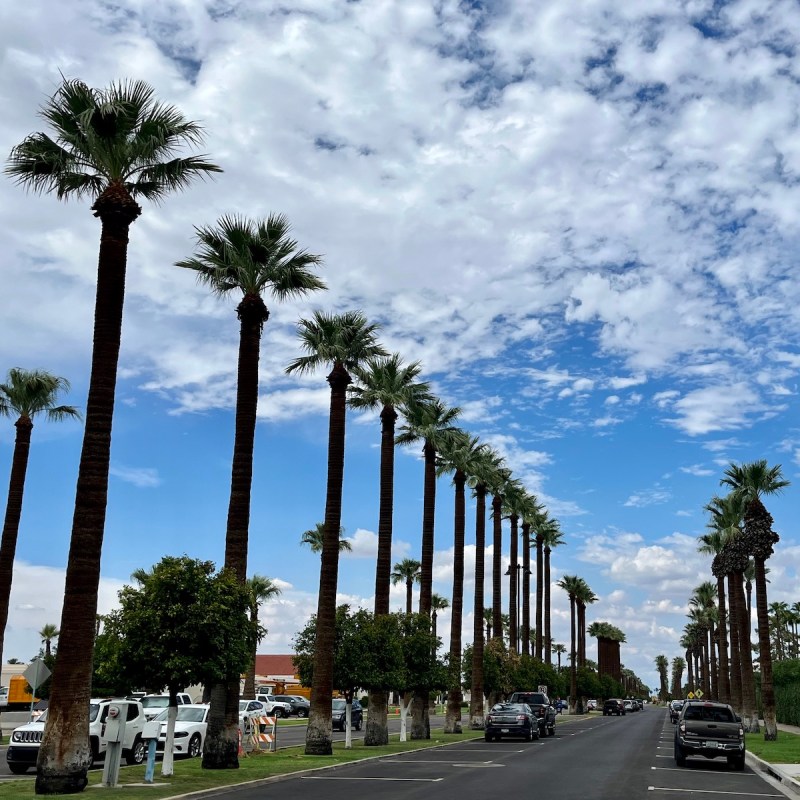
As one of 24 communities that make up Phoenix’s massive Valley of the Sun, little Litchfield Park can feel a bit under the radar. But, visit this small city in the western reaches of Arizona’s largest metro area and you’re sure to be charmed by the unique culture that arose more than a century ago on a mix of cotton farming, tire manufacturing, and desert/mountain terrain.
Videos by TravelAwaits
With two rugged mountain ranges as backdrops, Litchfield Park boasts tidy streets bordered by super-straight rows of towering palm trees that run alongside quaint hometown cafés and bustling chain restaurants and supermarkets.
Anchoring it all is one of the Phoenix area’s most historic resorts. The Wigwam Golf Resort and Spa is described on the Visit Arizona website as “an oasis of casual elegance” — a setting that has become synonymous with Litchfield Park. When I visited the Wigwam Resort recently, I was delighted by the old Arizona ambience, the cool pool/bar area, and the classic southwestern décor in the lobby spaces.
Here are seven reasons why Litchfield Park is worth a visit on your next trip to Phoenix.
1. Wigwam Golf Resort And Spa
The Wigwam has had a reputation of providing relaxed luxury to travelers since the early 1900s. The resort began as a small lodge during the rise of cotton ranching in the area, then it was officially opened as a resort in 1929.
Visit Arizona notes that the Goodyear Tire and Rubber Company sent executive Paul Litchfield to Arizona in 1916 to buy land for growing the cotton needed to produce the company’s tires. Litchfield “ended up falling in love with the area and turned Litchfield Ranch into the headquarters of what would eventually become Goodyear Farms,” says the website.
A central part of that early history was a lodge initially created as a place to house visiting Goodyear executives. It later became the destination-worthy Wigwam Resort.
Today, the Wigwam is a true desert paradise, boasting beautifully landscaped grounds and strings of lights that provide a wonderful glow on warm Arizona evenings. To help beat the hot temperatures typical in the Phoenix-area desert from spring through fall, the resort features three pools with water slides and lively atmospheres. The Wigwam also has three restaurants, a luxury spa, and 54 holes of championship golf.
Pro Tip: For casual al fresco dining, I loved the Wigwam Bar, a full-service eatery that features beautiful indoor seating, as well as a large outdoor patio area with fire pits, green grass, and lawn games. Even on the hot July evening that I visited, the shady patio was comfortable, with misters providing a cooling effect. The go-to menu item appeared to be the half-pound angus beef Wigwam Burger served with a stack of seasoned fries.
2. Old Litchfield Road
Old Litchfield Road cuts through the heart of Litchfield Park and passes by quintessential Valley of the Sun scenes of cactus and palm tree landscaping, golf courses, and a mix of shopping centers, fast-food restaurants, and small local stores and cafés.
Among the first things drivers will notice are the rows of impossibly tall palm trees, alongside vividly green lawns that front mid-century homes. It’s worth driving down the classic road just to take in the iconic Arizona city views.
At the intersection of Old Litchfield Road and Wigwam Boulevard, visitors will find a pretty shopping and dining area that features local favorites like the Park Café and the Old Pueblo Café.

3. White Tank Mountains Regional Park
The Phoenix area is bordered by a ring of mountain ranges, two of which lie within easy driving range of Litchfield Park. Towering over the city to the northwest are the White Tank Mountains, a hulking wall of ridges and canyons that rises to about 4,000 feet in elevation (compared to Litchfield Park’s 1,050 feet).
The White Tanks are the home of the sprawling White Tank Regional Park, which features about 30 miles of hiking, mountain biking, and equestrian trails. The excellent trail system features treks that range in length from about 1 mile to about 8 miles, and from easy to difficult.
One of the easiest and most popular trails is the Waterfall Trail, a 2-mile out-and-back trail near the neighboring community of Waddell. It passes by amazing desert terrain and ancient Indigenous petroglyph rock art. Part of the trail is concrete and wheelchair friendly, while part traverses a somewhat steep and rocky section of terrain. During wet weather, hikers on the dirt portion are sometimes treated to the sight of a waterfall cascading down the rock wall at the end of the trail.
4. Estrella Mountains Regional Park
Located near the meeting of the seasonal Gila and Agua Fria Rivers in the southwest Valley of the Sun, the Estrella Mountains are about 9 miles south of Litchfield Park in the neighboring city of Goodyear. The nearly 20,000-acre Estrella Mountains Regional Park consists of mostly pristine desert terrain, with some seasonal wetland areas during the wet winter and summer-monsoon seasons.
The Maricopa County Parks and Recreation Department’s website notes that the Sierra Estrella range, or Star Mountains, was once within the Mexican border and remained so until the Gadsden Purchase in 1853. Signs along the regional park’s trails tell the history. The parkland is criss-crossed with nearly 25 trails that range from easy to difficult. One of the easiest routes is the Quail Trail, a 2.1-mile spur trail that connects the park’s Nature Center and the 2.3-mile moderate Quail and Baseline Trail Loop.

5. Litchfield Park Historical Society Museum
Telling the story of Litchfield Park’s place in the rapid growth of the rubber tire industry, the Litchfield Park Historical Society Museum sits in a small building not far from the Wigwam Resort, at the corner of Litchfield and Camelback Roads.
Exhibits focus on a variety of topics, including the life of founder Paul Weeks Litchfield and his prominent role in Arizona’s 20th-century economy, as well as the story of Litchfield Park as a “company town” throughout the early 20th century.
Pro Tip: The museum has limited hours, mostly Wednesday through Thursday and some Saturdays, as well as by appointment, so it is best to call ahead before visiting.
6. Southwestern And Mexican Cuisine
From the breakfast huevos rancheros with eggs, salsa, black beans, and queso fresco to the lunchtime street tacos with carnitas and green chile pork, the Old Pueblo Café has the Mexican-cuisine scene covered.
And next door, the quaint Park Café offers a mix of Mexican and southwestern fare, with its south-of-the-border chorizo and poblano chile omelets and its lunches of shrimp ceviche and a southwest green chile and bacon burger. Both spots are located near the corner of Old Litchfield Road and Wigwam Boulevard, offering indoor and outdoor seating.
Other dining spots to try in Litchfield Park include Litchfields, the main dining room at the Wigwam Resort; the course-side Red Allen’s Bar and Grill at the Wigwam’s golf course; or the fun gastropub atmosphere at Ground Control Craft Food & Drink.
7. Wildlife World Zoo, Aquarium, And Safari Park
For an opportunity to safari through the habitats of cheetahs and giraffes, families head to the Wildlife World Zoo, Aquarium, and Safari Park, located in Litchfield Park and also near the larger communities of Glendale and Surprise.
The 100-acre zoo and aquarium features more than 600 species and boasts Arizona’s largest collection of exotic and endangered animals, along with rides, a petting zoo, and daily shows.
Weather In Litchfield Park
Like the rest of the Phoenix area, Litchfield Park experiences extreme heat in the summer months, followed by mostly warm and sunny conditions from late fall through early spring. June, July, August, and September all post average highs above 100 degrees Fahrenheit, with July averaging a high of 108.
Litchfield Park’s average highs drop to 89 degrees in October, 76 degrees in November, and 66 degrees in December. The season from late winter to early spring features perhaps Litchfield Park’s loveliest weather, with an average high of 72 degrees in February, 78 in March, and 86 in April.
